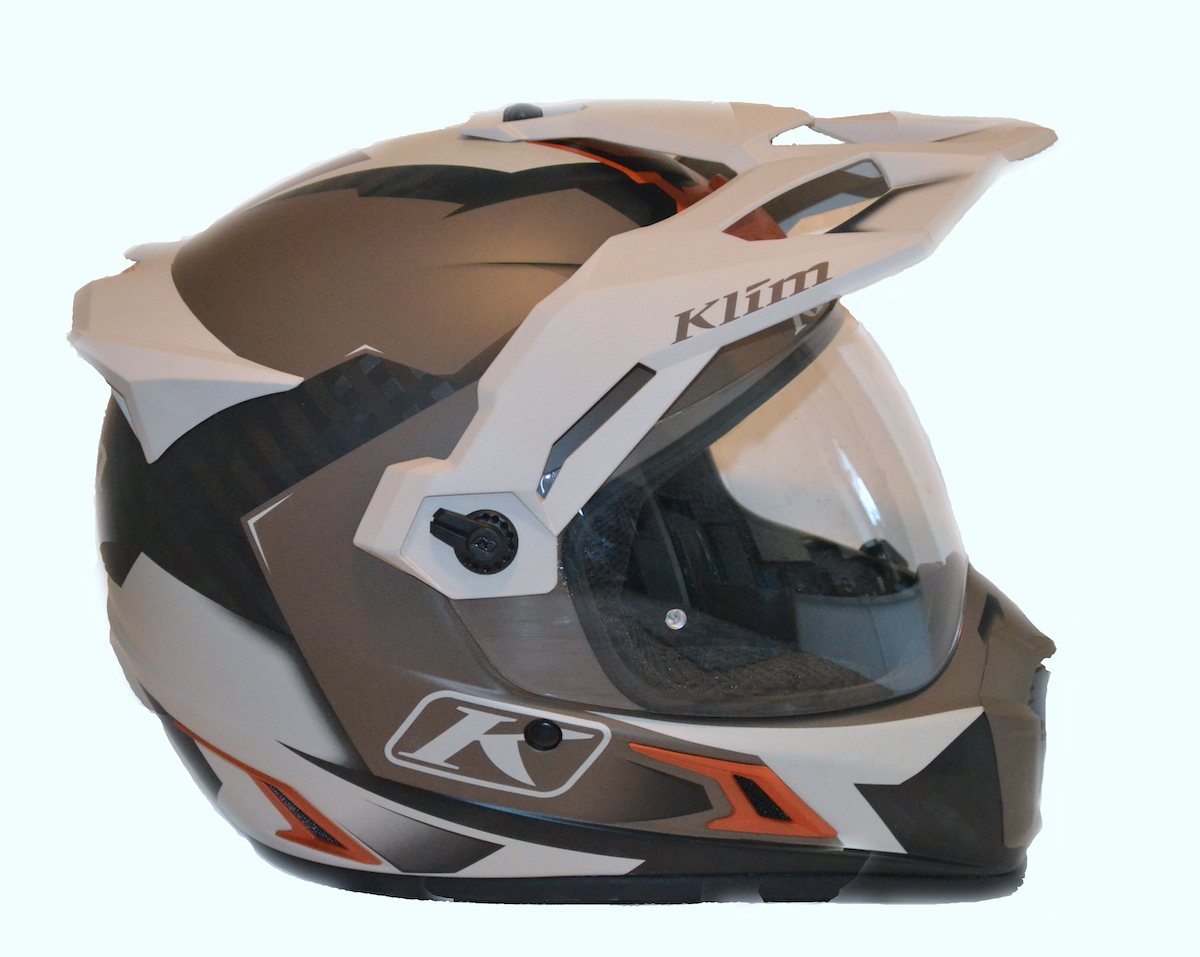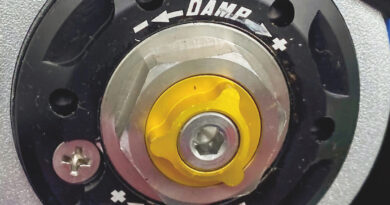First Look: Klim Krios Pro ADV helmet
It’s a longtime cliché in the realm of motorcycle gear reviews, but in all my writing about clothing, helmets, electronic gizmos and luggage systems, I’ve always resisted using the term “revolutionary.” However, looking at Klim’s Krios Pro helmet right out of the box, I find that term has never been more appropriate for four basic reasons: the helmet’s weight, its Koroyd liner, the Fidlock latching system and the Transitions face shield.
 Weight
Weight
In size medium, the Klim Krios Pro I ordered weighs in at about three pounds. Most of the full-face helmets I’ve used have always weighed four or more pounds. One pound of difference, whether you’re on a daylong slog on the slab or a bumpy single track, can make a world of difference. The hand-laid carbon fiber shell on the Krios is one feature allowing the helmet to be so light; reducing weight is another innovation making the Krios revolutionary.
Koroyd liner
Most helmets today—including ones at the highest end—use an expanded polystyrene (EPS) liner. Look in your helmet; that stuff that looks like Styrofoam crushes on impact, reducing the G-forces to your head. Instead, the Klim Krios Pro uses Koroyd, a honeycomb of thermally welded, copolymer extruded tubes. Already in use in bicycle, Formula One and fighter pilot helmets, it’s claimed (with some evidence) that using Koroyd can absorb 25% or more of the G-forces on impact compared to a conventional EPS liner. The Krios Pro exceeds ECE and DOT standards and probably anticipates the inevitable raising of those standards in a few years. As one would expect, in addition to being more energy absorbent and lighter, a Koroyd liner also increases ventilation since it’s 95% air, a welcome perk for any kind of rider.
Fidlock latching system
Most helmet manufacturers use traditional D-ring buckles or, in the case of helmets from Nolan, the MicroLock latch. The Klim Krios Pro is one of a small number using the Fidlock. As you join the two chin strap ends, a magnet grabs them together with a click. The latch is as secure as any other fastening system, but can be released easily by pulling a red tab. Besides being a quicker, more convenient way for buckling in (especially while wearing gloves), I would guess that in the event of a serious accident, that red tab release would make helmet removal easier for first responders.

Transitions® face shield
 Included with the purchase of a Klim Krios are two anti-scratch, polycarbonate face shields. One is a clear shield, the other is a photochromatic Transitions® shield that darkens in response to sunlight. When I checked the helmet going from complete darkness to brilliant sunlight, the shield went to full dark tint in less than a minute. One drawback (and Klim notes this in their instructions) is that when the Transitions® lens is retracted and used in conjunction with the brim, sunlight poking through the ventilation holes in the brim can cause uneven tinting, so that when the rider pulls the shield back down, there may be dark and clear spots. However, shading becomes uniform within a minute or so after the shield is lowered. The brim is easily removed with two levers and a small turnbuckle (the same operation for changing out the shield). Actually, the use of the Transitions® shield is another weight-saving feature, since a retractable sun visor is not required, nor is the larger shell size for a storage cavity. A PinLock® fog-resistant lens is also included and fits either shield.
Included with the purchase of a Klim Krios are two anti-scratch, polycarbonate face shields. One is a clear shield, the other is a photochromatic Transitions® shield that darkens in response to sunlight. When I checked the helmet going from complete darkness to brilliant sunlight, the shield went to full dark tint in less than a minute. One drawback (and Klim notes this in their instructions) is that when the Transitions® lens is retracted and used in conjunction with the brim, sunlight poking through the ventilation holes in the brim can cause uneven tinting, so that when the rider pulls the shield back down, there may be dark and clear spots. However, shading becomes uniform within a minute or so after the shield is lowered. The brim is easily removed with two levers and a small turnbuckle (the same operation for changing out the shield). Actually, the use of the Transitions® shield is another weight-saving feature, since a retractable sun visor is not required, nor is the larger shell size for a storage cavity. A PinLock® fog-resistant lens is also included and fits either shield.
At over $700, riders in the market for a new helmet may wonder if the Klim Krios Pro is worth the cost, just on the basis of its revolutionary features. Over the next few months, I plan to put the Klim through its paces both on- and off-road and should be able to come to an evidence-based verdict. Five things I especially want to evaluate on this unique lid are:
- Noise. I have a feeling the Koroyd liner may be noisier than a comparably priced helmet with an EPS liner. I’ll be curious to see if the removable wind guard under the chin helps with that.
- Comfort. Right now, the Krios liner feels plush, and Klim’s fit guide seems to be accurate, but a day-long ride will be the real test. Klim claims the two shell sizes and six different padding options should make the helmet comfortable for just about any size noggin.
- Klim says the helmet is equally at home on the highway or dirt. Since the brim and face shield can be removed easily without tools, and the field of view is designed to accommodate goggles, Klim may be justified in saying this helmet is suitable for ADV, dual-sport, trail and dirt riding.
- Durability. Though the helmet shell is carbon, the fasteners for the peak and face shield and other bits are not; how will they hold up?
- Ventilation. Like most helmet designers, Klim has tinkered with configuring ventilation vents on their helmets to strike a balance between exhausting heat, eliminating fogging and cutting noise. The Krios Pro has a large, adjustable chin vent and intake vents at the forehead. There are exhaust vents on both sides of the chin bar with a larger one at the rear under a spoiler. Klim has tried different configurations of vents in the past, and road tests will reveal if they’ve found a good combination.

Stay tuned for a more extensive field evaluation review coming in an August or September 2023 issue of Owners News with a Motorcycle Test Kitchen! video review right here on BMWOwnersNews.com.
Visit klim.com for more information and a video on the Klim Krios Pro. More information on the history, applications and physics of Koroyd’s protective qualities is available at koroyd.com, and fidlock.com offers more background on this unique fastening system.



